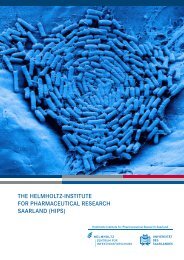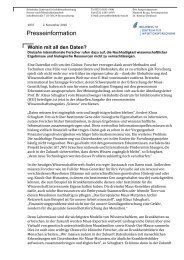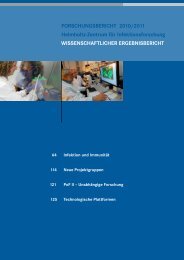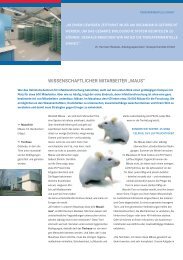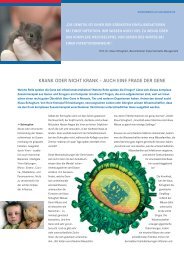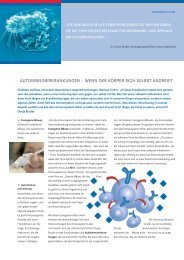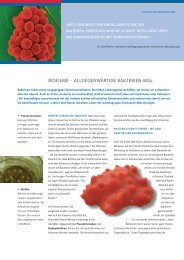144 SCIENTIFIC REPORTS | TWINCORE, Centre for Experimental and Clinical Infection <strong>Research</strong> GmbH 2. Mechanisms of hepatitis C virus replication and immune control In a hepatitis C virus (HCV) infection species-specific interactions with surface receptors such as CD81 play a central role. According to this, only chimpanzees and humans are naturally infected with HCV. After adaptation of HCV to a mouse CD81, it was possible to identify three mutations in the envelope glycoprotein of HCV which enhance the infection of cells with murine CD81 100-fold and thereby allow the HC cell entry into mouse cells without using human cofactors (Bitzegeio et al., <strong>2010</strong>). These studies raise the hope that it will one day be possible to establish a permissive immuno-competent small animal model for HCV infection. 3. Pathogen recognition and immune stimulation by dendritic cells Virus-induced type I interferon (IFN) responses may enhance cytotoxic T cell responses dramatically. This finding is surprising because IFN-responses reach peak serum levels within hours of infection, while cytotoxic T cell responses are maximally induced after approximately one week. The work by Frenz et al. has shown that IFNresponses enhance T cell proliferation by the stimulation of antigen-presenting cells as well as through the direct stimulation of T cells (Frenz et al., <strong>2010</strong>). 4. Immune subversion strategies In the context of chronic bacterial infections biofilms may develop which cannot be treated with normal antibiotics. We have succeeded in developing a new in vitro test system that allows the targeted search of novel compounds that inhibit biofilm formation (Pommerenke et al., <strong>2010</strong>). 5. Humanised mouse models Treatment options for various liver diseases are limited by the fact that syngeneic hepatocytes are not usually available. In the mouse system we have succeeded in developing a new process that allows the differentiation of induced pluripotent stem (iPS) in hepatocyte-like cells (Sancho-Bru et al., <strong>2010</strong>). • Bitzegeio J, Bankwitz D, Hueging K, Haid S, Brohm C, Zeisel MB, Herrmann E, Iken M, Ott M & Baumert TF, Pietschmann T (<strong>2010</strong>) Adaptation of hepatitis C virus to mouse CD81 permits infection of mouse cells in the absence of human entry factors. PLoS Pathogens 6: e1000978. • Frenz T, Waibler Z, Hofmann J, Hamdorf M, Lantermann M, Reizis B, Tovey MG, Aichele P, Sutter G & Kalinke U (<strong>2010</strong>) Concomitant IFNAR-triggering of T cells and of DC is required to promote maximal MVA-induced T-Cell expansion. European Journal of Immunology 40(10), 2769-2777. • Klages K, Mayer CT, Lahl K, Loddenkemper C, Teng MW, Ngiow SF, Smyth MJ, Hamann A, Huehn J & Sparwasser T (<strong>2010</strong>) Selective depletion of Foxp3+ regulatory T cells improves effective therapeutic vaccination against established melanoma. Cancer <strong>Research</strong> 70(20), 7788-7799. • Pommerenke C, Müsken M, Becker T, Dotsch A, Klawonn F & Häussler S (<strong>2010</strong>) Global genotype-phenotype correlations in Pseudomonas aeruginosa. PLoS Pathogens 6(8). pii: e1001074. • Sancho-Bru P, Roelandt P, Narain N, Pauwelyn K, Notelaers T, Shimizu T, Ott M & Verfaillie C (<strong>2010</strong>) Directed differentiation of murine-induced pluripotent stem cells to functional hepatocyte-like cells. Journal of Hepatology 54(1), 98-107. • Sawa S, Cherrier M, Lochner M, Satoh-Takayama N, Fehling HJ, Langa F, Di Santo JP & Eberl G (<strong>2010</strong>) Lineage relationship analysis of ROR t+ innate lymphoid cells. Science 330(6004), 665-669. Contact TWINCORE GmbH <strong>Zentrum</strong> für Experimentelle und Klinische Infektionsforschung Feodor-Lynen-Str. 7 | 30625 Hannover Telefon 0511 2200 27 102 | Fax 0511 2200 27 186 twincore@twincore.de | www.twincore.de
SCIENTIFIC REPORTS | TWINCORE, Centre for Experimental and Clinical Infection <strong>Research</strong> GmbH 145 Complete list of articles published in <strong>2010</strong> as well as articles published and “in press” in <strong>2011</strong> by employees working at TWINCORE <strong>Research</strong> group Prof. Kalinke • 1. Williams SK, Fairless R, Weise J, Kalinke U, Schulz-Schaeffer W & Diem R (<strong>2011</strong>) Neuroprotective effects of the cellular prion protein in autoimmune optic neuritis. American Journal of Pathology (in press). • 2. Gratz MS, Suezer Y, Kremer M, Volz A, Majzoub M, Hanschmann KM, Kalinke U, Schwantes A & Sutter G (<strong>2011</strong>) N1L is a virulence factor of ectromelia virus and essential for in vivo spread upon respiratory infection. Journal of Virology (in press). • 3. Grabski E, Waibler Z, Schule S, Kloke BP, Sender LY, Panitz S, Cichutek K, Schweizer M & Kalinke U (<strong>2011</strong>) Comparative analysis of transduced primary human dendritic cells generated by the use of three different lentiviral vector systems. Molecular Biotechnology 47(3), 262-269. • 4. Kochs G, Bauer S, Vogt C, Frenz T, Tschopp J, Kalinke U & Waibler Z (<strong>2010</strong>) Thogoto virus infection induces sustained type I interferon responses that depend on RIG-I-like helicase signaling of conventional dendritic cells. Journal of Virology 84(23), 12344-12350. • 5. Frenz T, Waibler Z, Hofmann J, Hamdorf M, Lantermann M, Reizis B, Tovey MG, Aichele P, Sutter G & Kalinke U (<strong>2010</strong>) Concomitant IFNAR-triggering of T cells and of DC is required to promote maximal MVA-induced T-Cell expansion. European Journal of Immunology 40(10), 2769-2777. • 6. Goossens P, Gijbels MJ, Zernecke A, Eijgelaar W, Vergouwe MN, van der Made I, Vanderlocht J, Beckers L, Buurman WA, Daemen MJ, Kalinke U, Weber C, Lutgens E & de Winther MP (<strong>2010</strong>) Myeloid type I interferon signaling promotes atherosclerosis by stimulating macrophage recruitment to lesions. Cell Metabolism 12(2), 142-153. • 7. Lang PA, Recher M, Honke N, Scheu S, Borkens S, Gailus N, Krings C, Meryk A, Kulawik A, Cervantes-Barragan L, Van Rooijen N, Kalinke U, Ludewig B, Hengartner H, Harris N, Häussinger D, Ohashi PS, Zinkernagel RM & Lang KS (<strong>2010</strong>) Tissue macrophages suppress viral replication and prevent severe immunopathology in an interferon-I-dependent manner in mice. Hepatology 52(1), 25-32. • 8. Prinz M & Kalinke U (<strong>2010</strong>) New lessons about old molecules: how type I interferons shape Th1/Th17-mediated autoimmunity in the CNS. Trends in Molecular Medicine 16(8), 379-386. Review. • 9. Murikinati S, Juttler E, Keinert T, Ridder DA, Muhammad S, Waibler Z, Ledent C, Zimmer A, Kalinke U & Schwaninger M (<strong>2010</strong>) Activation of cannabinoid 2 receptors protects against cerebral ischemia by inhibiting neutrophil recruitment. FASEB Journal 24(3), 788-798. • 10. Sender LY, Gibbert K, Suezer Y, Radeke HH, Kalinke U & Waibler Z (<strong>2010</strong>) CD40 ligand-triggered human dendritic cells mount interleukin-23 responses that are further enhanced by danger signals. Molecular Immunology 47(6), 1255-1261. • 11. Al Moussawi K, Ghigo E, Kalinke U, Alexopoulou L, Mege JL & Desnues B (<strong>2010</strong>) Type I interferon induction is detrimental during infection with the Whipple’s disease bacterium, Tropheryma whipplei. PLoS Pathogens 6(1): e1000722. • 12. Ilchmann A, Burgdorf S, Scheurer S, Waibler Z, Nagai R, Wellner A, Yamamoto Y, Yamamoto H, Henle T, Kurts C, Kalinke U, Vieths S & Toda M (<strong>2010</strong>) Glycation of a food allergen by the Maillard reaction enhances its T-cell immunogenicity: role of macrophage scavenger receptor class A type I and II. Journal of Allergy and Clinical Immunology 125(1), 175-183 e171-111. • 13. Kern M, Popov A, Scholz K, Schumak B, Djandji D, Limmer A, Eggle D, Sacher T, Zawatzky R, Holtappels R, Reddehase MJ, Hartmann G, Debey-Pascher S, Diehl L, Kalinke U, Koszinowski U, Schultze J & Knolle PA (<strong>2010</strong>) Virally infected mouse liver endothelial cells trigger CD8+ T-cell immunity. Gastroenterology 138(1), 336-346. • 14. Malinarich FH, Grabski E, Worbs T, Chennupati V, Haas JD, Schmitz S, Candia E, Quera R, Malissen B, Förster R, Hermoso M & Prinz I (<strong>2010</strong>) Constant TCR triggering suggests that the TCR expressed on intestinal intraepithelial γδ T cells is functional in vivo. European Journal of Immunology 40(12), 3378-88. • 15. Schneider CK, Salmikangas P, Jilma B, Flamion B, Todorova LR, Paphitou A, Haunerova I, Maimets T, Trouvin JH, Flory E, Tsiftsoglou A, Sarkadi B, Gudmundsson K, O’Donovan M, Migliaccio G, Ancans J, Maciulaitis R, Robert JL, Samuel A, Ovelgonne JH, Hystad M, Fal AM, Lima BS, Moraru AS, Turcani P, Zorec R, Ruiz S, Akerblom L, Narayanan G, Kent A, Bignami F, Dickson JG, Niederwieser D, Figuerola-Santos MA, Reischl IG, Beuneu C, Georgiev R, Vassiliou M, Pychova A, Clausen M, Methuen T, Lucas S, Schussler-Lenz M, Kokkas V, Buzas Z, MacAleenan N, Galli MC, Line A, Gulbinovic J, Berchem G, Fraczek M, Menezes-Ferreira M, Vilceanu N, Hrubisko M, Marinko P, Timon M, Cheng W, Crosbie GA, Meade N, di Paola ML, VandenDriessche T, Ljungman P, D’Apote L, Oliver-Diaz O, Buttel I & Celis P (<strong>2010</strong>) Challenges with advanced therapy medicinal products and how to meet them. Nature Reviews Drug Discovery 9(3), 195-201. Review. • 16. Buttel IC, Voller K & Schneider CK (<strong>2010</strong>) Immunogenicity and its impact on benefit/risk considerations in the authorisation of biopharmaceuticals. Current Drug Safety 5(4), 287-292. Review. • 17. Goetz KB, Pfleiderer M & Schneider CK (<strong>2010</strong>) First-inhuman clinical trials with vaccines-what regulators want. Nature Biotechnology 28(9), 910-916. Review. • 18. Schussler-Lenz M & Schneider CK (<strong>2010</strong>) [Clinical trials with advanced therapy medicinal products]. Bundesgesundheitsblatt Gesundheitsforschung Gesundheitsschutz 53(1), 68-74. Review. <strong>Research</strong> group Prof. Pietschmann • 1. Frentzen A, Hüging K, Bitzegeio J, Friesland M, Haid S, Gentzsch J, Hoffmann M, Lindemann D, Zimmer G, Zielecki F, Weber F, Steinmann E & Pietschmann T (<strong>2011</strong>) Completion of hepatitis C virus replication cycle in heterokaryons excludes dominant restrictions in human non-liver and mouse liver cell lines. PLoS Pathog (in press). • 2. Gentzsch J, Hinkelmann B, Kaderali L, Irschik H, Jansen R, Sasse F, Frank R & Pietschmann T (<strong>2011</strong>) Hepatitis C virus complete life cycle screen for identification of small molecules with pro- or antiviral activity. Antiviral <strong>Research</strong> 89(2),136-48. Epub <strong>2010</strong> Dec 15. • 3. Montserret R, Saint N, Vanbelle C, Salvay AG, Simorre JP, Ebel C, Sapay N, Renisio JG, Bockmann A, Steinmann E, Pietschmann T, Dubuisson J, Chipot C & Penin F (<strong>2010</strong>) NMR structure and ion channel activity of the p7 protein from hepatitis C virus. Journal of Biological Chemistry 285(41), 31446-31461. • 4. Steinmann E & Pietschmann T (<strong>2010</strong>) Hepatitis C virus P7 - a viroporin crucial for virus assembly and an emerging target for antiviral therapy. Viruses <strong>2010</strong> 2(9), 2078-2095 (Review). • 5. Bitzegeio J, Bankwitz D, Hueging K, Haid S, Brohm C, Zeisel MB, Herrmann E, Iken M, Ott M & Baumert TF, Pietschmann T (<strong>2010</strong>) Adaptation of hepatitis C virus to mouse CD81 permits infection of mouse cells in the absence of human entry factors. PLoS Pathogens 6: e1000978. • 6. Bürgel B, Friesland M, Koch A, Manns MP, Wedemeyer H, Weissenborn K, Schulz-Schaeffer WJ, Pietschmann T, Steinmann E & Ciesek S (<strong>2010</strong>) Hepatitis C virus enters human peripheral neuroblastoma cells - evidence for extra-hepatic cells sustaining hepatitis C virus penetration. Journal of Viral Hepatology Jun 23 [Epub ahead of print].



